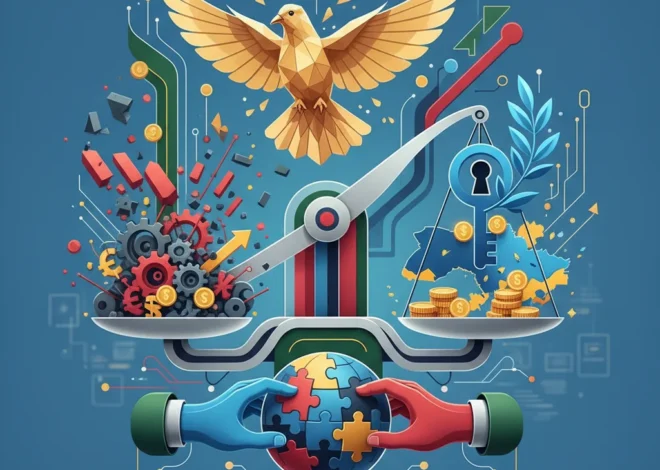
Beyond the Grid: Solving the Complex Puzzle of Modern Finance
For many, the morning ritual of coffee and a crossword is a gentle mental warm-up—a structured world of intersecting words where every clue has a logical answer. The grid offers a sense of order and solvability. Yet, when we turn our attention to the world of finance, investing, and economics, the puzzle becomes infinitely more complex. The clues are cryptic, the grid is constantly shifting, and the answers are rarely black and white.
Today’s financial landscape is a grand, intricate crossword, challenging even the most seasoned investors, finance professionals, and business leaders. The intersecting lines of macroeconomic policy, technological disruption, and geopolitical shifts create a puzzle that demands more than just knowledge—it requires foresight, adaptability, and a deep understanding of the interconnected forces at play. In this analysis, we will decipher some of the most critical “clues” shaping our modern economy, from the rise of disruptive financial technology to the delicate balancing act of central banking, providing a framework for navigating this complex grid.
The Nine-Letter Clue: A Digital Revolution in Finance
One of the most compelling clues in our financial puzzle is a nine-letter word that has fundamentally rewritten the rules of banking and transactions: BLOCKCHAIN. This, along with the broader fintech movement, represents a seismic shift away from centralized, legacy systems toward a more decentralized, efficient, and accessible financial future. The impact of this revolution on the stock market, traditional banking, and the global economy cannot be overstated.
Financial technology, or fintech, is no longer a niche sector but a dominant force. From seamless digital payment platforms to AI-powered robo-advisors managing investment portfolios, technology is democratizing access to financial services. According to a report from Boston Consulting Group, the global fintech sector is projected to grow to a staggering $1.5 trillion in annual revenue by 2030, a sixfold increase from 2021 (source). This isn’t just growth; it’s a fundamental rewiring of the industry’s DNA.
At the heart of much of this disruption is blockchain, the distributed ledger technology that powers cryptocurrencies and enables new forms of secure, transparent transactions. While initially synonymous with Bitcoin, its applications now extend far beyond digital currencies. Blockchain is being explored for everything from streamlining cross-border payments and trade finance to creating new, tokenized assets that represent ownership in real-world items. This technology challenges the very role of traditional intermediaries in finance, promising lower costs and greater efficiency in trading and settlement processes.
Labour's Internal Tremors: Gauging the Economic Shockwaves for UK Investors
The Macroeconomic Riddle: A Global Balancing Act
While technology provides clues about the future, the current state of the global economy presents a more immediate and perplexing riddle. Central banks worldwide are engaged in a high-stakes balancing act, attempting to curb inflation without triggering a deep recession. This delicate dance of monetary policy has profound implications for every investor and business leader.
For years, markets were buoyed by an environment of low interest rates and quantitative easing. Today, the puzzle has changed. Central banks, including the U.S. Federal Reserve and the European Central Bank, have been forced to raise rates aggressively to combat persistent inflation. This shift has altered the risk-reward calculus across all asset classes, from equities to bonds, and has cooled the once red-hot stock market. Navigating this environment requires a keen understanding of economics and the signals being sent by policymakers.
The global nature of this challenge adds another layer of complexity. A rate hike in the United States doesn’t just affect the American economy; it ripples across the globe, influencing currency exchange rates, capital flows, and the borrowing costs for emerging markets. As a recent IMF analysis highlights, global growth is slowing amid widening divergences, making a unified “solution” to the economic puzzle nearly impossible.
To illustrate the varying economic pressures, consider the recent inflation data from major economic blocs.
| Region/Country | Peak Inflation Rate (Recent Cycle) | Current Policy Interest Rate (Approx.) | Key Economic Challenge |
|---|---|---|---|
| United States | 9.1% (June 2022) | 5.25% – 5.50% | Balancing inflation control with maintaining labor market strength. |
| Eurozone | 10.6% (October 2022) | 4.00% (Deposit Facility Rate) | Combating inflation amid risks of economic stagnation and energy insecurity. |
| United Kingdom | 11.1% (October 2022) | 5.25% | Tackling “sticky” core inflation while facing a cost-of-living crisis. |
| Japan | 4.3% (January 2023) | -0.10% | Exiting decades of deflation without destabilizing its bond market. |
The Banking Conundrum: Evolve or Be Replaced?
Caught between the tectonic plates of technological disruption and macroeconomic uncertainty is the traditional banking sector. The conundrum for these legacy institutions is stark: evolve rapidly or risk becoming a relic. The pressure is on to modernize operations, enhance customer experience, and integrate the very technologies that threaten to make them obsolete.
This evolution is already underway. Banks are investing billions in digital transformation, moving away from brick-and-mortar branches toward sophisticated mobile apps and online platforms. This isn’t just about a better user interface; it’s about leveraging data and AI to offer personalized services, improve risk management, and automate back-office functions. The use of AI in trading, for example, allows firms to execute complex strategies and analyze market data at speeds no human could achieve.
However, this transformation is not without its challenges. Legacy IT infrastructure, regulatory hurdles, and a deeply ingrained corporate culture can slow the pace of change. Meanwhile, nimble fintech startups, unburdened by these constraints, continue to chip away at the most profitable segments of the banking industry, from lending to wealth management. The successful banks of the future will be those that can either innovate internally or strategically partner with the fintech firms they once saw as adversaries. A Financial Times crossword may be a solitary pursuit, but survival in modern banking is about collaboration.
The Kidult Economy: How Lego and Pokémon are Powering a Surprising Market Rebound
The Investor’s Gambit: Finding the Solution in the Grid
So, how does one “solve” this complex financial crossword? For investors and business leaders, the solution isn’t a single word but a dynamic strategy built on awareness, diversification, and a forward-looking perspective.
First, embrace the technological clues. Understanding the trajectory of financial technology is no longer optional. Investors should consider how fintech, blockchain, and AI will impact their portfolios, both as disruptive threats to incumbent companies and as powerful growth opportunities in their own right. This means looking beyond traditional sector classifications and evaluating companies based on their technological adaptability.
Second, respect the macroeconomic riddles. The era of predictable monetary policy is behind us. A successful strategy now requires a deeper appreciation for economics. This involves staying informed about central bank decisions, inflation trends, and geopolitical developments that can affect market sentiment and asset valuations. Diversification remains the most reliable tool for managing uncertainty, spreading investments across different asset classes, geographies, and sectors to mitigate risk.
Finally, focus on fundamental value. In a volatile market, the noise can be deafening. The principles of value investing—identifying strong, well-managed businesses with durable competitive advantages and reasonable valuations—become more important than ever. While the grid shifts, the core tenets of sound investing and strategic business management provide a stable anchor.
India's IPO Boom: From Valuation Frenzy to a New Era of Financial Maturity
Conclusion: The Unfinished Puzzle
Unlike a newspaper crossword, the puzzle of the global economy is never truly finished. New clues emerge every day, and old answers become obsolete. The interconnectedness of finance, technology, and economics means that a solution in one part of the grid can create a new problem elsewhere.
However, by breaking down the complexity, we can begin to see the patterns. The rise of fintech and blockchain is a clue about the future of value exchange. The actions of central banks are a riddle about the price of stability. And the evolution of banking is a conundrum about adaptation. For those who are willing to engage with these challenges, to continuously learn and adapt their strategies, the puzzle of modern finance—while daunting—is not unsolvable. It is the most compelling game of strategy in the world.


